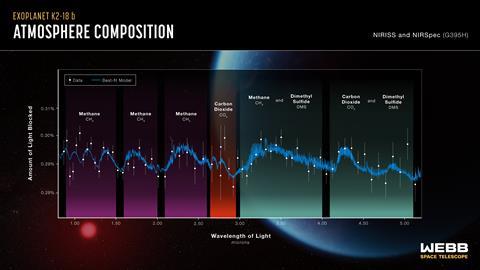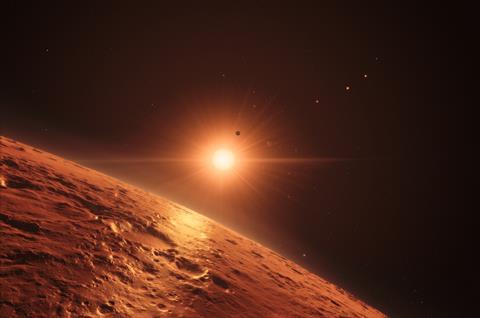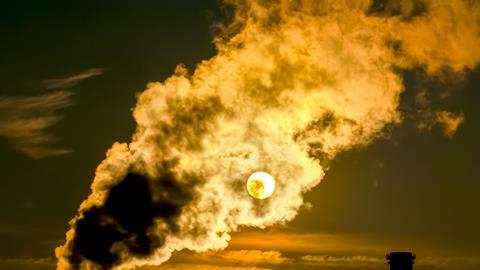With new space telescopes opening cosmic windows, the age-old dream of finding life beyond Earth is shifting from science fiction into scientific reality. We are no longer just imagining aliens, we’re scanning starlight looking for a sign of life. Among the most promising indicators of biogenic elements are volatile organic compounds produced by life forms. The detection of specific metabolites such as dimethyl sulphide (DMS) and related compounds may hint at extraterrestrial biology.
The discovery of over 5,000 exoplanets since the early 1990s has revolutionised our understanding of how we see the universe. The Earth is no longer the only known world orbiting a star; now, the opportunities to find a potentially habitable planet are becoming countless. With missions like the James Webb Space Telescope (JWST), Ariel, LIFE, and HabEx concepts, we move closer to finally answering the question of whether we’re alone.
But in the first instance, how do we define a biosignature? Although defining what counts as a “biosignature” is challenging since it inevitably reflects our Earth-based perspective, the most simplistic and unified definition links it to a substance - an element, molecule, or pattern - that can originate specifically from a biological process. With the progress in understanding biochemical processes and general molecular biology, most research has been built on the idea that biosignatures can be identified through basic molecules (e.g. DNA, lipids), atmospheric gases (e.g. O₂, CH₄) typical of Earth life, or in geology, with recognisable forms like stromatolites or microfossils.
What makes a good biosignature?
For a trace of life to be considered as an ideal biosignature, it has to satisfy the following criteria: unambiguously biological, persistent in the environment, and detectable remotely. For example, on Earth, molecular oxygen (O₂) is a compelling biosignature, since it is the volatile consequence of oxygenic photosynthesis. This process is driven by sunlight and dominates energy capture on Earth’s surface, where electrons are transferred from water to carbon dioxide (CO₂) with the production of waste oxygen. Until recently, O₂ was assumed to have insignificant abiotic planetary origins, with photochemical reactions powered by the Sun’s UV radiation producing just tiny quantities and no substantial geological sources.
Gases like methane (CH₄) and nitrous oxide (N₂O) can be biological or geological in origin. Methanogenesis, for instance, is one of the most ancient metabolic processes that involves the anaerobic respiration of chemotrophic microorganisms, which produce methane via the oxidation of CO₂ and hydrogen. A similar mechanism occurs in remote habitats on the ocean seabed, called hydrothermal vents - fissures on the Earth’s crust in which the efflux of magmatic material comes into contact with deep-sea water. The chemical reaction resulting from this phenomenon leads to the production of methane.
The highest biosignature signal is generally produced when these gases coexist in chemical disequilibrium. Earth’s biosphere also emits a wide range of volatile organic compounds (VOCs) and other metabolites, some of which may serve as promising future biosignature targets.

DMSP: The smell of the sea
Dimethylsulfoniopropionate (DMSP) is a sulphur-containing compound produced in massive quantities by marine phytoplankton, macroalgae, and some terrestrial plants. DMSP has a function in stress tolerance, chemotaxis, carbon and sulphur cycling storage, and climate-active gas production.
When DMSP is broken down - often by bacteria - it releases DMS, a gas that escapes into the atmosphere. On Earth, DMS contributes to cloud condensation nuclei and plays a role in climate regulation, making it a rare example of a biologically produced gas with planetary-scale consequences.
DMS or related sulphur compounds are recently becoming more relevant as a potential organic combination to be detected in the atmosphere of an exoplanet, especially when it is grouped with other biological gases. Their presence could pinpoint active microbial ecosystems or even plant-like photosynthetic life. Importantly, DMS has very few known abiotic production routes at the planetary scale, which enhances its value as a biosignature.
Most recently, research conducted by the University of Cambridge in 2025, using the JWST data, has found convincing evidence of sulphur-based molecules such as DMS in the atmosphere of the exoplanet K2-18b, a possible ocean-covered world located 124 light-years away. More intriguingly, these gases appear to be at concentrations thousands of times higher on K2-18b, raising exciting possibilities about the presence of life.

In particular, astronomers have analysed mid-infrared transmission spectrum data specifically showing how a planet’s atmosphere absorbs starlight at mid-infrared wavelengths, which is the wavelength at which many important molecules - like water vapor, methane, carbon dioxide, and potential biosignature gases - have strong, distinct absorption features. As the planet passes in front of its star, the gases present are revealed. After filtering the data and removing the noise, the research group at the University of Cambridge matched the results with pre-existing spectrum data, finding a close tie with the DMS molecule.
Source JWST MIRI (James Webb Space Telescope mid-infrared transmission spectrum) instrument used to obtain the light absorption spectrum of K2-18b. The observed spectrum is displayed by the data points with error bars, and the key characteristics of DMS and DMDS are noted.
However, experts are cautious, emphasising the need for further data and analysis to determine if these chemicals are the consequence of biological activity or unknown abiotic processes. DMS has also been identified in comets and interstellar space, demonstrating its ability to develop in the absence of life. Given these limitations and the likelihood of undiscovered chemical reactions, experts urge caution. The discovery represents significant advances in exoplanet science, but further confirmation and thorough investigation are required before declaring that life exists beyond Earth.
Other noteworthy metabolites and gas-phase biosignatures
DMS is not the only complex compound targeted for the search for biosignatures; plants and algae on Earth emit a variety of volatile compounds, including isoprene, pigments such as chlorophyll and carotenoids, and various terpenoids. These emissions reflect metabolic processes, including photosynthesis and responses to stress or pathogens that may have been detectable throughout much of Earth’s history (over 500 million years). The production and stability of VOC gases depend on local environmental chemistry, biological evolution, and the host star’s radiation. On exoplanets with different conditions, even trace biosignature gases on Earth could be more abundant. Additionally, life with alternative biochemistries might produce entirely different detectable gases. The section that follows reviews alternative biosignature gases, their biological and non-biological sources, and their potential detectability in exoplanet atmospheres.
Isoprene (C5H8), for instance, is produced in enormous quantities globally by terrestrial plants. This biogenic gas is subject to the rapid degradation of radicals, producing a variety of reactive chemicals that play a major role in the generation of aerosols. As a result, despite its high rate of formation, C5H8 has a low concentration (spatially and temporally dynamic, ranging from ppt to the ppb levels) due to its photochemical lifespan of less than three hours in Earth’s current atmosphere. In an H₂-rich atmosphere, this process would be extended, allowing the accumulation and the detection of its spectrum in UV or infrared wavelengths.
Similarly, halomethanes are also considered a valuable biosignature that on Earth undergoes destruction. These molecules derived from methane, such as methyl chloride (CH3Cl) and methyl bromide (CH3Cl), have no known strong abiotic sources at detectable levels. A team of researchers has investigated the use of photochemical and spectral models for Earth-like planets orbiting various stars (including TRAPPIST-1e). The authors showed that these halomethane molecules can accumulate to detectable levels, especially around the smallest and coolest type of stars, and that multiple methylated gases can enhance the overall signal, making detection more feasible.
While no single molecule may provide irrefutable proof of life, the simultaneous detection of several metabolites, especially in chemical disequilibrium, can build a stronger case.

What’s next? new chemical clues and the future of life detection
Better biochemistry models and telescopes will be essential for biosignature detection in the upcoming decades. We continue to find new microbial pathways and distinctive metabolites that may help guide our search as we investigate Earth’s extreme habitats, from acid mine drainage to Antarctic lakes.
An intriguing example is provided by DMSP and its relatives, which are globally relevant while being invisible to the naked eye. They are modified by evolutionary processes and may provide planetary feedback. If their existence on a far-off world were ever verified, it might usher in a new era of biology.
At its core, the hunt for metabolism - tiny chemical traces that reveal how cells function - is the search for extraterrestrial life. In this regard, microbial volatiles such as DMSP and plant-linked metabolites provide a diverse and mainly unexplored class of biosignatures. These overlooked substances might turn out to be some of the most telling indicators of life in the cosmos as technology develops and our knowledge of planetary systems grows.
Further reading
Dimethylsulfoniopropionate (DMSP): from biochemistry to global ecological significance.
New Constraints on DMS and DMDS in the Atmosphere of K2-18 b from JWST MIRI.








No comments yet